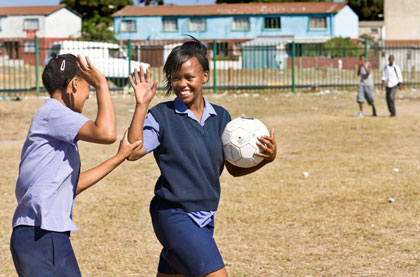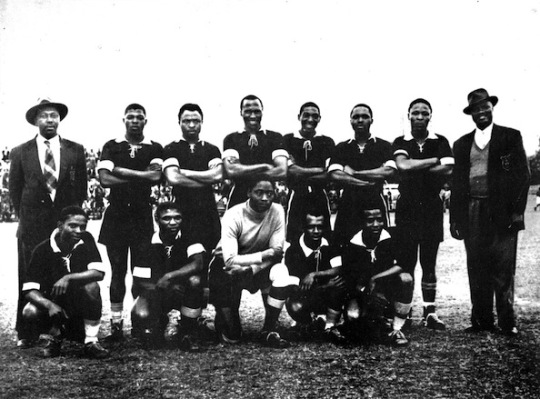
Photo: Durban & District African FA select team, Rhodes Centenary tournament, Salisbury, Rhodesia (1953)
Football is Coming Home is pleased to receive and publish a guest essay by Zipho Dlangalala, a South African fútbologist who has coached players and trained coaches for many years at all levels. He is a teacher by profession. It has been lightly edited for style.
Guest Post by Zipho Dlangalala (makhandaz@hotmail.com)
KWAZULU-NATAL—All sports are played in, and influenced by, past and present social conditions. This is largely, if not entirely, because sport is played by people who are social beings.
When we see most of our South African players playing the same way, looking like identical midfielders, we should know instantly that we are looking at them with “foreign eyes.” They will always look like that as long as we evaluate them with foreign tools and criteria.
To African eyes, it is those midfield players that should reveal the nature and inclination of our players. Their creativity and desire to care for the ball—the uninhibited attraction to artistic modes of play—are great assets that we should have treasured so that their game exhibits the same attributes found in them naturally, at least before being diluted.
Regrettably, the Apartheid philosophy and its legacy was too strong for most of us. Based on seeing life through Master-Slave, Boss-Subordinate, Superior-Inferior, Rich-Poor, Educated-Illiterate, Advanced-Primitive, civilized-uncivilized relationships, this “baaskap” paradigm has engulfed us. Even when we know it is not desirable, we often find ourselves promoting it, advocating on its behalf through actions more than words.
It makes us feel acceptable and progressive to be seen as “the master.” We do everything and anything to feel accepted and to get approval from those who represent “the master” perspective. It has been engraved in us to look for this approval, otherwise we feel we do not have the capacity to stand by ourselves and achieve success on our own. The desire to be associated with, to be affiliated to, approved by, “the master” is hard to resist for most. It is this prevailing mentality in South Africa that undermined indigenous cultures, languages, restricted people’s movement and freedom to associate, to think, to explore, to design, to invent, to discover.
It is a “total control” approach of life. It attempts to control what people think and learn. Given the slightest opportunity, it dictates LIFE to each and every person who is supposed to be subordinated (and limited) to its wishes and desires.
In a cultural and socio-economic environment shaped by a social hierarchy long based on race, fertile ground exists for past tendencies to endure. The more things change, the more they stay the same.
Football under these conditions cannot be sustained, let alone developed.
Looking at football through a particular lens inevitably results in the game looking in a particular manner. Are we using proper African perspectives to look at the game as it is in Africa? Are our views coloured to give us a special feeling? Are we ready to bring something new to world football or are we content to follow established paths and continue to consume what is already in the market? We are entrepreneurs and have skills. We need to develop them and show our own ideas to the world. We need to create something new in our football for the world to sit up and take note.
Tag: development
This is the third post in Pelle Kvalsund‘s series rethinking Sport Development and Sport For Development. (Click here and here to read the previous posts.)
By Pelle Kvalsund
If you have visited sub-Saharan Africa then you know that Non-Governmental Organizations (NGOs) are everywhere, even in sports.
In 1999, I traveled from Norway to South Africa to work for Sports Coaches’ Outreach (SCORE). This NGO aims to create sporting opportunities for children and youth in disadvantaged urban and rural communities. The agenda was clear and the focus simple: Sport for all!
Since the pioneering days of the 1990s, thousands of new local and international sport for development organizations (S4D) began operating all around the world (partial list here). Most of these organizations feed on a broken local sport system to create, often successfully, high demand for their services. Sometimes their agendas are not clear or straight forward.
Sport NGOs are manna from heaven for Western governments and donors eager to boast about their efforts in developing civil society and reaching grassroots targets in the Global South. By offering sporting activities for boys and girls, S4D NGOs appear to have successfully “taken over” parts of the mandate for youth development usually given to local (including national) sport associations.
Backed by solid support from northern sponsors (public and private), many S4D groups have developed a strong internal organizational capacity that enables them to raise funds, submit grant proposals, market themselves, and run and evaluate activities according to the foreign aid industry’s terms and latest trends. These NGOs succeed by investing in their capacity and development. In the process, they create self-sustainable structures that go beyond their original function as “gap fillers” for outstretched African sport providers.
This process has fostered adversarial, even hostile, relationships between the NGOs and government-mandated sport bodies. Such rivalries stem from perceptions that the success of S4D NGOs stems at least in part from the sports governing bodies’ mismanagement and mistakes. In some cases, this animosity targets northern brokers who are seen to be undermining the local sport custodians’ mandates. The rivalry is rooted in struggles for material benefits, such as access to a new Land Cruiser, as much as by the fact that many NGOs and football academies are producing young footballers for sale in European and Asian markets.
Some governments and sport governing bodies have been developing strong policies and clear strategies that chart a coherent, productive direction for sport development in their countries. Chasing aid money, the NGOs often fail to align themselves with host countries’ strategic plans and begin operating in a parallel universe. This parallel universe does not only function in isolation; at times, it also produces some peculiar activities. As S4D’s agendas change because of funding levels and requirements, the sport activities they deliver also change.
Over the years, I have observed how using sport to address serious issues like AIDS, farming, sanitation, traffic safety (as well as some religious agendas) has backfired. NGOs forget (or choose to ignore) that the kids come first and foremost to play sports. They do not enjoy standing quietly in line passively listening to lengthy explanations about how to wash hands properly or safely cross the street.
Some of the S4D activities are so far removed from sport that they confuse both the boys and girls and sport development practitioners like myself. Such a wrong-headed approach has led to many youths choosing to pursue other activities and dropping out of sport all together.
What would the African and Asian sport associations (discussed in my previous post here) look like and how would they function today if northern brokers, supported by Western governments and companies, had invested the same amount of human and material capital in capacity-building and long-term development? The Norwegian Olympic and Paralympic Committee and Confederation of Sport, an umbrella organization for all national sports federations in Norway, has adopted this strategy. It will be interesting to follow its development over time.
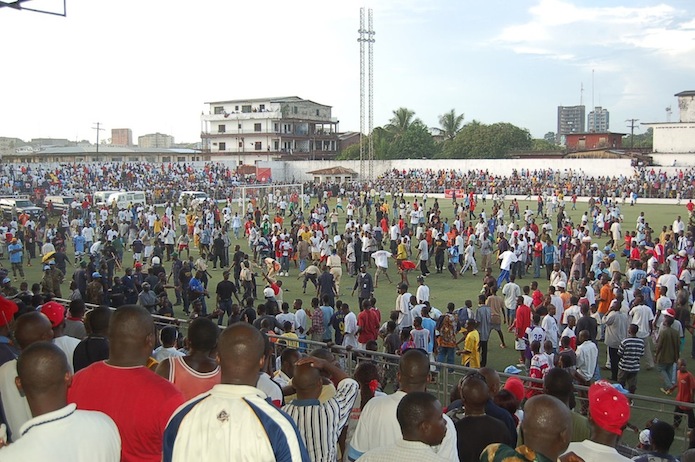
Football is Coming Home is pleased to welcome Pelle Kvalsund for a new series on the field of sport development. How can we develop regular long-term sport opportunities for a youth population that is predicted to double in the next thirty years? How do we ensure that the services produced for these athletes are of quality and value so that we can retain both athletes and coaches? This first post outlines some of the main institutional and economic challenges.
By Pelle Kvalsund
Pelle Kvalsund, international sport development consultant, is a former athlete, coach, and physical education teacher from Norway. As a consultant for over 15 years, he has worked in many countries including Vietnam, Sri Lanka, Burundi, Zambia, and Bosnia. Pelle has served a number of international organizations, both within sport and the area of community development, and is currently an advisor for the Norwegian Olympic and Paralympic Committee and Confederation of Sport and their partners in the global south. He is the author of “Sport as a Response to Emergencies and Disasters” in Sport, Peace and Development, edited by Keith Gilbert and Will Bennett (free download here).
I’m at the National Stadium in Monrovia, Liberia, in 2007, watching a women’s international football match between the host nation and Nigeria. The stadium is jam-packed with fans and UN peacekeepers. It ends 1-1. A fair result from my perspective as a neutral observer, but not for the home fans. A riot breaks out. The crowd storms the pitch and the UN peacekeepers fire teargas to save the unfortunate referee from the mob.
There is a lot to be said about this rowdy incident, but above all else it illustrates the extraordinary popularity of football and the social importance of sport, particularly in sub-Saharan Africa and other parts of the world where resources are scarce and life is generally challenging and unstable.
And it is precisely sport’s cultural significance that provides those of us working in sport development with a foundation on which to build sport programs that offer positive activities and outlets for many children and youth.
Let me start by doing something that I hate doing, but have become quite good at: identifying a stereotype. I do this to present a general image of the field of sport development in the Global South (though it applies to parts of global north too).
Such a country boasts a Ministry of Sport, which is paired with the Ministry of Youth or the Ministry of Education. The department of sport is of very high personal and political interest within government circles due to the widespread popularity of sports in society (particularly football), but the same interest is not reflected in the budget allocations. Most of the sport budget is used to pay the government employees (directly and by extension) and to maintain their status. Some of the money pays for upkeep of facilities and the participation of national teams in international competitions. Most of the remaining funds find their way to the national football association, while only a symbolic sum goes to athletics, basketball, volleyball, and other sports with athletes capable of winning a medal for the country on the global stage.
Administratively, the country has a national sport council or commission (the extension mentioned above) mandated to roll out government policies, distribute government funds, provide logistical support for major competitions, and govern and support the associations. A national Olympic committee bring selected athletes to the Olympic Games every four years. In addition, it has the financial ability to support elite athlete development and organizational capacity building through a central program called Olympic Solidarity.
Each sport also has a national association that generally consists of an “elected” board and president, and a general secretary. The president makes the important decisions and the general secretary does the work. There is no office. The association’s documentary records are tucked away in a briefcase or (if lucky) in the general secretary’s laptop. The associations run their operations according to a calendar of events.
There is no long-term plan, just day-to-day survival. Money is impossibly scarce and there is neither sufficient equipment nor adequate facilities. Instead of a youth development plan, potential athletes are recruited from a few well-endowed schools that host inter-scholastic sport competitions once or twice a year. In the case of football, private academies and sport and development NGOs of varying size and quality also train young boys. (Girls are rarely included in these programs.)
This stereotype of how sport is organized and run in a country of the Global South should help to better understand the stark challenges before us and how they shape the multiple and diverse attempts and approaches used to develop sport in poorer regions of the world. In the blog posts that follow, I intend to share reflections based on my experiences in Africa and beyond to spark a dialogue with readers about the differences between “Sport Development” and “Sport For Development” and why these matter. I look forward to the conversation.
Part 2 of my interview with Boyzzz Khumalo (part 1 is here) opens with a description of the harrowing injury that prematurely ended his Major League Soccer career.
Boyzzz reflects on the inherent fragility of professional sports, the importance of higher education for life after soccer, and his extensive youth coaching experiences in both Soweto and in Michigan.
Boyzzz’s deeply personal commitment to community upliftment comes through in a detailed discussion of the challenges and hopes for the Umhlaba Vision Foundation. Anyone interested in getting involved or learning more about Umhlaba can send email to boyzzzkhumalo80 AT gmail.
Boyzzz Khumalo: From Soweto to Michigan
Thabiso “Boyzzz” Khumalo grew up in Soweto, South Africa, around the corner from the homes of two Nobel Peace laureates: Nelson Mandela and Archbishop Desmond Tutu. Like so many boys in the land of apartheid, he spent every moment of free time playing soccer and dreaming of becoming a professional player overseas. Unlike most of them, however, Boyzzz fulfilled his dream
On July 22, I sat down with Boyzzz for an interview on the campus of Michigan State University. We’d been hoping to do an interview ever since we met in November 2013 when he visited my “Sport in African History” seminar for a screening and discussion of Invictus.
This week was an especially opportune time to chat about Boyzzz’s sporting life because on Sunday, July 27, Lansing United, his current team, travels east to New Jersey to play a National Premier Soccer League semifinal against New York Red Bull Under-23.
How does a young man from Soweto end up playing in Michigan? In part 1 of our interview, Boyzzz shares memories of anarchic pickup games in Soweto; his first experience in the U.S. during a youth tournament that would change his life; and then scoring his first MLS goal for DC United.
Boyzzz also discusses the work of the Umhlaba Vision Foundation–a nonprofit organization he founded in 2007 with two South African friends. The goal of Umhlaba (meaning “world” in the Zulu language) is to change the lives of young Sowetans by creating a positive development environment through sport and education and bringing student-athletes to the United States. For more information about the foundation please email Boyzzz (boyzzzkhumalo80 AT gmail).
Don’t forget to come back tomorrow for part 2 of the interview!
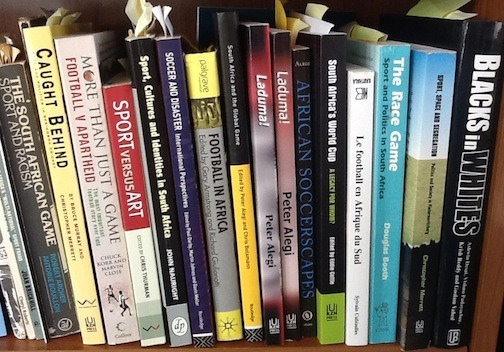
Guest Post by *Marc Fletcher
Gloomy skies and wet weather greeted the Research Forum on South African Football held at the University of Johannesburg (UJ) last month. The bleak conditions made for an intimate crowd, but the academics, journalists and sports practitioners in attendance were rewarded with three strikingly different presentations on varying aspects of the “beautiful game” in South Africa. The aim of the forum was to advance the specialized study of soccer in the country and beyond.
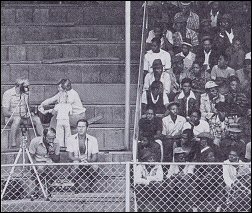 First up was Chris Bolsmann, a South African sociologist based at Aston University, Birmingham. His paper entitled “Professional Football in Apartheid South Africa: Leisure, Consumption and Identity in the National Football League, 1959-1977” provided a rich history of the whites-only National Football League (NFL) during apartheid. The common misconception of South African football is that it has historically been, and continues to be, an exclusively black, working-class game. Yet, Chris’s work challenges such a perception and begins to reconstruct a past that is often forgotten or even ignored. Matches in this white league were staged in front of segregated crowds. A successful corporate affair, the NFL attracted a host of world-renowned players, including George Best and Bobby Charlton. In concluding that the NFL became the leisure and sporting entertainment of choice for significant numbers of white and black (particularly Indian and Coloured) South Africans, this history emphasized how football in South Africa has had a more diverse support base than is often acknowledged.
First up was Chris Bolsmann, a South African sociologist based at Aston University, Birmingham. His paper entitled “Professional Football in Apartheid South Africa: Leisure, Consumption and Identity in the National Football League, 1959-1977” provided a rich history of the whites-only National Football League (NFL) during apartheid. The common misconception of South African football is that it has historically been, and continues to be, an exclusively black, working-class game. Yet, Chris’s work challenges such a perception and begins to reconstruct a past that is often forgotten or even ignored. Matches in this white league were staged in front of segregated crowds. A successful corporate affair, the NFL attracted a host of world-renowned players, including George Best and Bobby Charlton. In concluding that the NFL became the leisure and sporting entertainment of choice for significant numbers of white and black (particularly Indian and Coloured) South Africans, this history emphasized how football in South Africa has had a more diverse support base than is often acknowledged.
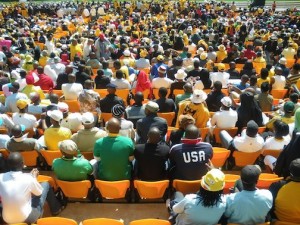 My paper on “Divisions, Difference and Encounters in Johannesburg Soccer Fandom,” explored contemporary cultures of fandom beset by race and class divisions, where domestic football is regularly constructed as an Africanized space without white supporters. However, through an ethnography of Kaizer Chiefs, Bidvest Wits, and Manchester United supporters’ clubs in Johannesburg, I began to explore the deeper complexities, where supporters on the margins of these groups began to engage with the other. In doing so, some fans challenged these social barriers in football and thus reinterpreted their understanding of soccer fandom and their wider experiences of everyday life in the city.
My paper on “Divisions, Difference and Encounters in Johannesburg Soccer Fandom,” explored contemporary cultures of fandom beset by race and class divisions, where domestic football is regularly constructed as an Africanized space without white supporters. However, through an ethnography of Kaizer Chiefs, Bidvest Wits, and Manchester United supporters’ clubs in Johannesburg, I began to explore the deeper complexities, where supporters on the margins of these groups began to engage with the other. In doing so, some fans challenged these social barriers in football and thus reinterpreted their understanding of soccer fandom and their wider experiences of everyday life in the city.
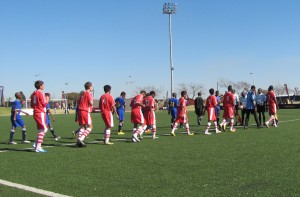 Chris Fortuin, based in the Department of Sport and Movement Studies at UJ, gave the third paper–an eye-opening account of the grim state of youth development in South African football. It was alarming to hear the inadequate ratio of qualified youth coaches to players in South Africa compared to some of the giants of international soccer, especially Spain. The shortage of such coaches, along with the absence of a coherent development plan at the national level, is harming the game at all levels and has contributed to the malaise of the men’s national team, Bafana Bafana.
Chris Fortuin, based in the Department of Sport and Movement Studies at UJ, gave the third paper–an eye-opening account of the grim state of youth development in South African football. It was alarming to hear the inadequate ratio of qualified youth coaches to players in South Africa compared to some of the giants of international soccer, especially Spain. The shortage of such coaches, along with the absence of a coherent development plan at the national level, is harming the game at all levels and has contributed to the malaise of the men’s national team, Bafana Bafana.
The presentations encouraged members of the audience to think more seriously about football as an academic field of inquiry. During the second half of the forum panelists responded to numerous questions from the floor. One question stuck out, one that is often asked; why are black South Africans not writing about this subject? It is true that much of what is written on the subject is by foreigners like me. But a main goal of football scholars, regardless of origin, is to empower South African students in the humanities and social sciences (and other fields) with tools and desire to critically engage with football studies.
With questions on the presentations filling up the second half, the question of where does the academic study of South African football go from here was left unresolved. Events such as the UJ forum can play a vital role in motivating South African scholars to research and write about their game. Clearly, football is a legitimate and fascinating area of research. But many more events like the forum are needed to further develop the field and chart future directions.
To this end, readers of this blog who are in the Johannesburg area, are welcome to attend the UJ Wednesday Seminar Series on Wednesday, May 8, at 3:30pm, where I will be presenting a paper entitled “Reinforcing Divisions and Blurring Boundaries: Race, Identity and the Contradictions of Johannesburg Soccer Fandom.” For details about the event click here.
The journey continues.
*Marc Fletcher, a postdoctoral fellow at the University of Johannesburg, blogs at One Man and His Football: Tales of the Global Game. Follow him on Twitter: @MarcFletcher1
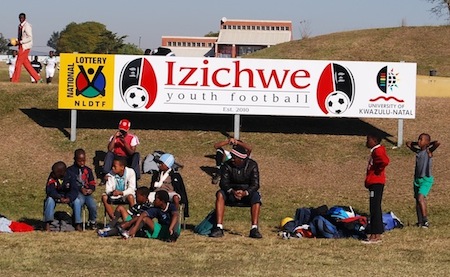
In the wake of Pitso Mosimane’s firing as Bafana Bafana head coach, there seems to be general agreement in South African football circles that a plan is needed to develop the local game constructively and sustainably.
On this blog, Mohlomi Maubane recently argued in favor of a German model that synchronizes the interests of the FA, the national team, and of professional clubs. “It is by virtue of young players being trained well that the German national team, and any other national team, can realise its full potential,” added Ted Dumitru and Sipho “King K” Kekana over at maximalfootball.com. “Lack of technical education in this vital aspect made many nations, including SA, compete without an identity and the results have been disastrous,” the two experts point out.
On June 9-10, 2012, the national finals of the under 15 boys’ Manchester United Premier Cup provided some clues about what lies ahead for South African football. At the Nike Football Training Centre in Klipspruit, Soweto, Ajax defeated SuperSport United in the final (2-1) to qualify for the global finals in China in July. The rest of the field featured Orlando Pirates, Izichwe FC, Bidvest Wits, School of Excellence, Diambars, and Mamelodi Sundowns.
According to observers’ accounts, most teams at the Premier Cup fielded sides of tall, strong boys indulging in well-rehearsed kick-and-rush football. Two exceptions stood out: Izichwe FC and School of Excellence. The case of Izichwe, an extraordinary program based at the University of KwaZulu-Natal in Pietermaritzburg, illustrates how making highly technical footballers out of promising teenagers requires not only financial resources and qualified coaches, but also time and patience.
Izichwe distinguishes itself in a number of ways from the vast majority of youth programs in South Africa and elsewhere on the continent. Founded in 2010, when my family had the privilege of being welcomed into the Izichwe clan, the academy got its name from the regiment (ibutho) of Shaka kaSenzangakhona, the founder of the Zulu kingdom. It operates on a shoestring budget compared to the PSL youth teams in the Premier Cup. It is a not-for-profit organization in which the parents and sponsors — both local and international — actively participate in shaping the sporting and educational development of each youngster.
After intense daily training sessions, the Izichwe boys, many of whom come from humble backgrounds, remain on the University of KwaZulu-Natal campus for a meal and to complete their homework before returning home for the night. Developing responsible citizens is considered just as important as training future members of Bafana Bafana. From a football standpoint, Thabo Dladla, Izichwe’s technical director, points out that while Izichwe coaches understand the importance of the team their priority is individual development. The coaching staff works assiduously to develop the technical, tactical, psychological, physical and emotional aspects of the boys’ game. Another important aspect of the Izichwe approach is the lack of an overbearing, ambitious owner, the kind of person who regularly exerts pressure on coaches and players to deliver trophies and obey the dictatorship of results.
For Bafana Bafana to improve, the quality of play in the Premier Soccer League — the richest league in Africa — must improve; but this cannot happen if football development programs fail to provide players under the age of 16 with the multiple skills required for successful professional careers. Izichwe shows the way forward. As we say in isiZulu: “Phambili!”.
